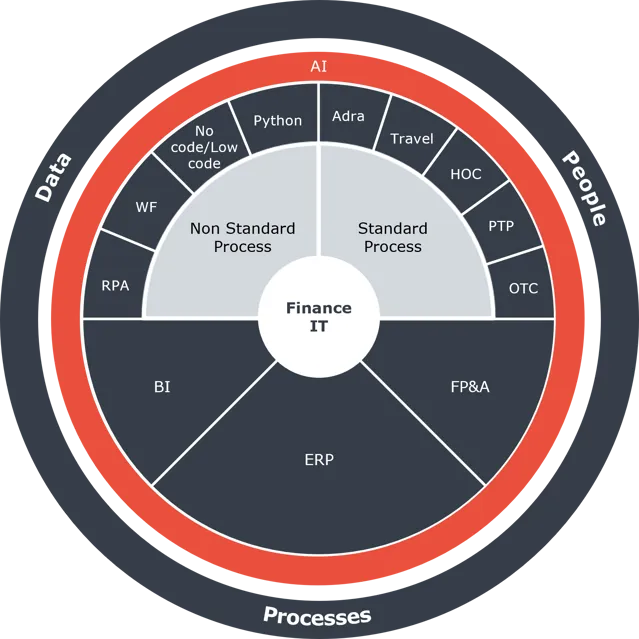Why do you need a BI solution?
That's a good question. And the truth is that there may be several reasons why a BI solution is the right way to go for you. Maybe the possibility of updating data quickly is high on your wish list, enabling you to send up-to-the-minute figures to the management upon request.
Maybe transparent models are what you strive for so that complexity, heavy maintenance, and the risk of errors are wiped away. Or increased confidence in your reporting and quality may also be the main reason for your flirtation with a BI solution.
The great advantage of a BI solution is that the comprehensive interactivity of the management reporting makes it easy to explore the figures and dig into their correlations when having to explain why the results look as they do.
Not to mention the spin-off that a BI solution helps to release resources so that your skilled employees can dedicate their capacity to value-creating activities rather than operations.
May I help you?

Meet Basico's BI Framework
Though we say it ourselves, we at Basico are skilled within BI solutions. This means that we can help you convert your data into value and create transparency and insight into your business. So that the layers of management and the executive offices have the best basis for making a decision.
When helping with a BI solution, we base our work on the model below, which illustrates our Basico BI Framework.

Analytics BI model
The purpose of the model is to find out from where your headache emanates - whether it has been caused by you having to build your back-end part with a data platform and integrations for various source systems, or by you having to visualise your data through Power BI in the front-end, or by both.
The model consists of six phases, mapping the process from the construction of databases and source systems to hand-over to operation, where our finest job is the guide you through the entire journey or the necessary phases.
Below, the individual phases are elaborated:
- Phase 1: Database architecture, building and implementing your data platform, and ensuring that the necessary dataflows for the source systems are under control.
- Phase 2: Data validation, ensuring that your data are correct and reflect the business since you master data (customer data, finance accounts, etc.) must be under control to be able to create reliable reports.
- Phase 3: Data modelling, which is the first step towards building an overall model, visualising your business data. Often, this means that we build a data cube that models an aspect of your business such as your financial figures.
- Phase 4: Data visualisation and reporting, which is about designing and building reports by means of a reporting software such as Power BI. Then, you can get effective visualisations using, for example, SQL and DAX, just as it's possible to link governance to the reports, enabling you to manage viewers' rights.
- Phase 5: Data analysis, which is about identifying which KPIs are best at illustrating how the business performs. Subsequently, they should be visualised in an insightful way.
- Phase 6: Manage BI, which is the hand-over of the completed reporting platform of which you may take over operations or we will perform the maintenance of your new-built platform.
The model is accompanied by four overall roles - making up our BI framework. The roles can be performed either internally or by external advisors. It depends on which clever people you have on board and whether they have the time needed to do the job.
Below, the roles are elaborated on:
BI tools for any scenario
This was a brief description of what we can do to boost your data by means of a BI solution. This being said, our framework is not a 'one-size fits all' model, and we can tailor the solution according to your temper and requests.
If, for example, you would like to get started quickly without any major 'up-front' costs, a cloud-based solution such as Microsoft Azure may be the right thing for you.
Microsoft Azure allows you to create a data platform without major 'up-front' investments where data can be collected and distributed from one place, such as ERP systems, HR tools, CRM, etc. The advantage of this solution is automatic updating, making it possible to ensure backup of data, security, accesses, API calls, etc.
If, on the other hand, you would like to visualise your data and automate your reporting, tools like Power BI or Tableau are useful. Using these, you can create fully interactive reports providing real insight into your business.
The advantage of this solution are visualisations rich in information that ensure fast and efficient distribution of knowledge across the organisation. And the finishing touch is the possibility of automating your reporting, thereby leaving manual and often tiresome processes in the past. Instead, you can spend your time on activities with which data and technical solutions cannot help you.
What's your need?
Whether you request an 'end-to-end' solution to the implementation of, for example, an Azure platform and Power Bi reporting or maintenance of an already existing solution, Basico can offer the experience needed and skilled helping hands - the decisive thing is that we find a solution that fits the specific needs of your business.
Full-circle competences
Finance IT Services' digitalisation circle shows which areas of competence we can bring into play when digitalising the financial processes of your company with a holistic point of departure.
When helping to digitalise and automate a Finance function, we take pride in combining the applications and tools that meet your specific needs. And in a way ensuring that the solution supports the data, processes, and people working hard behind the lines.
You can click on the various areas in the figure below and read more about the many skills presented in Finance IT Services' digitalisation circle.


 en
en
 da
da
